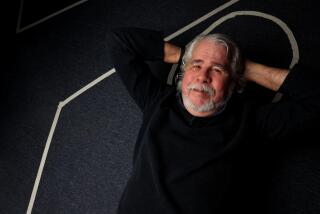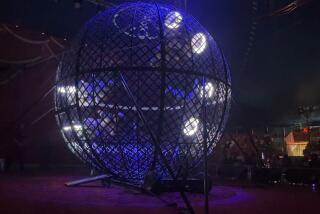Rock of Ages Witnesses Man
It’s not uncommon for rock stars to appear onstage, but “Promised Land” might be the first work in theater history to have a rock as its star.
The slab of stone at the center of this decade-old intimate epic without words, given its belated West Coast premiere Friday and Saturday at the Irvine Barclay Theatre as part of the Eclectic Orange Festival, attains almost talismanic force by the end of the performance’s magical single hour. But that wouldn’t surprise anyone who has been to such ancient sites as Stonehenge or Avebury and knows the power of stone.
In this collaborative work of Turin, Italy’s Teatro dell’Angolo and Montreal’s Les Deux Mondes theater troupes, the rock is the enduring constant throughout the course of the formation of the earth, the dawn of man and the erratic development of human civilization.
In a narrative that uncannily echoes that of Stanley Kubrick’s “2001: A Space Odyssey,” the theatrical vision is as elemental as Kubrick’s evolutionary epic and as different as could be in its alternately brilliant, disturbing and witty abstraction of human activity and natural forces.
We’re never in outer space here, but the stage space is nevertheless expansive. The writing, directing and designing quintet of Nino d’Introna, Daniel Meilleur, Graziano Melano, Giacomo Ravicchio and Monique Rioux break down this odyssey into 13 sections of dynamically varying length and mood.
What’s instantly remarkable is the framing of the stage. The curtain is raised only a few feet above the stage itself, creating an enormous wide-screen peephole effect. The ultra-wide stage pictures enable the audience to see clumps of earth suddenly falling to the ground, then the emergence out of nowhere of human arms and legs as people get their feel of the place.
With the rock a kind of mute, neutral witness, human folly, labor and courage play out on this humble yet portentously felt piece of land.
A Cain and Abel-type murder happens early, followed by farming, fishing (a noisy offstage cat gets into the act) and a man alone in a boat who thinks of leaving, then decides to stay--only to be hunted by an aboriginal man.
In this section alone, the mastery of stage magic is on virtuoso display: The feeling of a boat floating on an offstage body of water is suggested by the tugging and pulling of the boat rope and then the rope’s easy undulation as the boat is docked; and just as the boatman seems as free as Robinson Crusoe without his Man Friday, the pursuing aboriginal suddenly appears, again, out of nowhere.
While passages of history are clearly being told, Les Deux Mondes and Teatro dell’Angolo don’t identify specific historical moments, but find the right iconic suggestion for an era.
The brief meeting of a wealthy woman and a beggar suggests the climate of rich and poor divisions that led to worldwide political revolutions in the 18th and 19th centuries, and an escaped prisoner (finding a fresh use for the rock as a crude ax with which to remove his chains) who is ultimately captured suggests the era of slavery.
This capture is consistent with a running theme in “Promised Land”: that failure is almost always close at hand in anything we do. A charming exception is a pair of turn-of-the-century sunbathing lovers who spat and make up, with the man drawing a heart on the backside of the rock.
The later sections are where the Quebecois and Italian companies pull out the stops with some explosive and astonishing images, from the poison-gas holocaust landscapes of World War I to the postwar cleanup of laying down turf--except on the rock.
Perhaps the only misjudged scene in terms of length is the semi-slapstick depiction of a hapless golf game on the same grass. It serves up a different kind of physical comedy than anything else in the evening, but leads to an amazing view of that offstage body of water, which we’re suddenly in, because the rock has been dumped there.
In the coup de grace of the finale, the rock is retrieved and--voila!--gently preserved by white-robed scientists as the star attraction in a rock museum.
Thus, just as this extraordinary theater piece has recounted for us the history of life on earth, so the scientists use the rock to recount the same story in a different way. Art and science can appreciate nature, but have somehow permanently altered it.
This is the kind of visually sophisticated, nonverbal theater that’s utterly missing in America’s theatrical mix but which many Canadian, European and Asian companies thrive on. (Fans of the Montreal-based Cirque du Soleil, now in Santa Monica, would instantly see the connections to this show.)
Also un-American is how actors Renald Laurin, Yves Simard (replacing the injured Meilleur), France Mercile and Rioux perform as a malleable, nearly faceless ensemble.
More to Read
The biggest entertainment stories
Get our big stories about Hollywood, film, television, music, arts, culture and more right in your inbox as soon as they publish.
You may occasionally receive promotional content from the Los Angeles Times.










